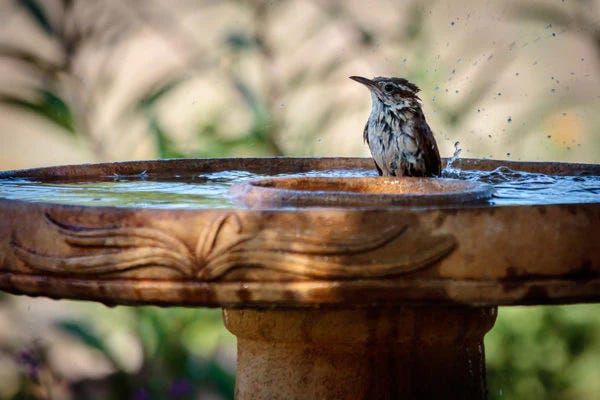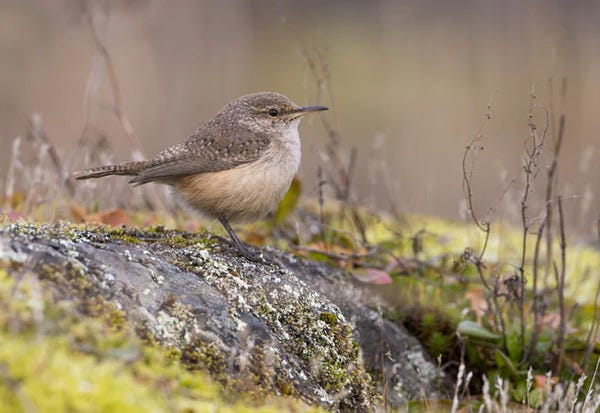
Wrens are feisty, intelligent birds that can be a true delight to see in your yard. There are nearly 80 species of wrens in the Troglodytidae bird family and they have diverse preferences. The most common backyard wrens in North America can be easier to attract than many birders realize. The key to successfully attract wrens is to thoughtfully create a bird-friendly yard that offers wrens exactly what they need.
Our Backyard Wrens
There are several wrens in North America that can be coaxed to visit yards.
The House wren (Troglodytes aedon) is the most common, found throughout the United States. This is a somewhat pale bird with darkly barred wings and a relatively long tail.
The Winter wren (Troglodytes troglodytes) is darker than the house wren overall, with a notably smaller tail and shorter and more delicate bill. These birds are more northerly and are found throughout the boreal forests of Canada as well as in both the eastern and western United States. They're missing from the Great Plains.
The Carolina wren (Thryothorus ludovicianus) is a larger wren with warm brown upper parts, yellowish underparts, and a white throat. The head is also marked with a broad white eyebrow. These wrens are popular guests in the eastern and southern United States year-round.
The Bewick's wren (Thryomanes bewickii) is paler and more grayish than the Carolina wren, with a noticeably long bill. They are most often seen along the Pacific Coast and in the southwestern United States.
The Cactus wren (Campylorhynchus brunneicapillus) is another large southwestern wren with bold dark spotting on its underparts and a dark throat and broad white eyebrow.
The Rock wren (Salpinctes obsoletus) is smaller and paler than the cactus wren, with only faint spotting on its upper parts and buffy coloration below. Rock wrens are most often seen in dry, rocky habitats throughout the western United States.
Other species of wrens, including the marsh wren, sedge wren, and canyon wren, are much less likely to appear in even the most wren-friendly yards, but rare sightings can still be possible.
Food for Wrens
All wrens have similar food preferences. These birds have a great appetite for insects, snails, and slugs. Minimizing insecticides and pesticides in the yard will ensure a healthy, abundant food source for wrens. Leaving leaf litter intact will give wrens plenty of space for foraging on the ground. These birds will also pluck spiders from webs, and will glean ants, gnats, and other insects from foliage and tree bark.
At feeders, wrens will happily snack on mealworms and crickets. Suet, peanut butter, and shelled peanuts are other favorite treats, and they're best offered in shallow dishes or tray feeders for easy access. Planting native berry-producing shrubs will also give wrens an attractive winter food source long after most insects have vanished.

Wrens Need Water
All wrens need water, particularly in desert habitats or other dry regions. That is, except for rock wrens, which are known to get all their water from their food. Because these birds have shorter legs, shallow bird baths just 1-1.5 inches deep are best. Heated bird baths are essential to provide liquid water in winter regions when other water sources are frozen. Bird baths and fountains with small streams, dribbles, or wigglers will attract wrens' attention with sparkles and splashes. Both pedestal and ground-level bird baths can be attractive to wrens.
See also: 8 Things You Should Know Before Installing a Birdbath
Wren-Friendly Shelters
These small birds will happily roost in dense, thicket-like shrubbery and brush piles. Rock piles and wood piles are also good wren shelters. Wrens will use roost boxes with 1.25-1.5-inch entrances. Because wrens can initially be shy, landscaping that creates corridors of dense shelter will help them move about the yard more comfortably.
During the breeding season, most wrens will easily use bird houses with appropriately sized entrances. These birds can also be very creative about nesting spots. They may build nests in any suitable nook or cranny, such as flowerpots, coffee cans, shoes, on top of tires, or inside grill covers.
Waiting for Wrens
Wrens can be shy, and birders should watch carefully for these birds to first arrive in the yard. Once wrens learn about the resources a yard offers, however, they will become more comfortable. Their natural curiosity and intelligence will quickly become apparent. Positioning feeding areas and bird baths in a quiet corner will help wrens feel more comfortable at first. Before you know it, these spritely birds will be flitting all over the yard and you can enjoy their company throughout the year.
See also: Birds Hate These Foods






